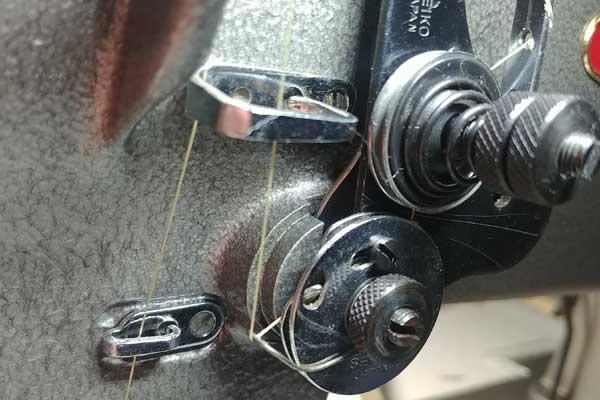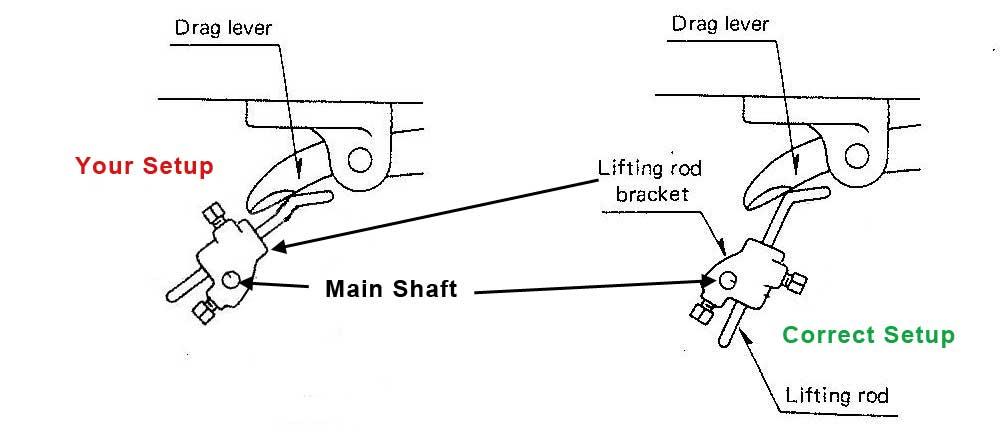-
Posts
347 -
Joined
-
Last visited
Content Type
Profiles
Forums
Events
Blogs
Gallery
Everything posted by JJN
-

Picked up a used Juki DDL 8700H with servo for $150
JJN replied to ELeBlanc's topic in Leather Sewing Machines
@ELeBlanc, if the table and motor are nice, you can sell the head and use the table and motor as a host for another walking foot machine. At that price, you can sell the head and keep the rest for free (350 value). I just picked an 8700 yesterday for that exact purpose. I got it for a Juki LU-563 head (factory new) that needed a table. -
That is a domestic machine. You do not want a domestic machine. Look for an upholstery class industrial machine. Try craigslist.
-

Looking for an Engineer's Manual for a Juki DLN-9010A
JJN replied to JJN's topic in Leather Sewing Machines
@Gregg From Keystone Sewing, I found a PDF of the Juki SC-920 Engineer's Manual and I am posting a link to it here for anyone else who might need it. sc-920-engineers-manual.pdf -

Looking for an Engineer's Manual for a Juki DLN-9010A
JJN replied to JJN's topic in Leather Sewing Machines
Thanks Gregg. Yes, that is the manual I am looking for now. -

Looking for an Engineer's Manual for a Juki DLN-9010A
JJN replied to JJN's topic in Leather Sewing Machines
@Gregg From Keystone Sewing, thanks, but I already have all of those manuals. There does not appear to be an Engineer's Manual for the DNL-9010A. I was able to get the Engineer's Manual for the DDL-9000 that has many similarities to the DNL-9010A. I now realize that I am asking for the wrong manual. I want to change some settings in the SC-920 controller. The instruction manual, that I already have, has a notice to purchase the Engineer's Manual before making certain changes. So I am really looking for the SC-920 Engineer's Manual. I see that it exists on the Juki.com bookstore, but I cannot order from there unless I am a dealer. -
@Gregg From Keystone Sewing thank you for confirming this. Do you stock this part?
-
This is what I found on ebay. It does not list the LS-1341 but it does list the LS-341N and the Pfaff 545, 1245. This is what makes me think that they are the same part. https://www.ebay.com/itm/1-PCS-212-29356-BOBBIN-CASE-FOR-JUKI-LS-321-341N/152748186412 THIS LISTING IINCLUDES :1 PCS High quality BOBBIN CASE CAP FOR 1.JUKI LS-321 -341N (212-29356) 2.MITSUBISHI LY3-6840-BOT 3.YAKUMO 321L 341L (115470005) 4.GOLDEN WHEEL CS-8810G, 8233 ,8243 5. JUMBO KING WR-341 6.KING'S HC-616,618 7.MILLLION SPEICAL MS-1245,-1341 8. PFAFF 1241~1246 ,1242-720 ,1244-748,541~546,551~555 (91-018348-91) 9.TYPICAL WANPING TW1-1245,TW3-341 10.NITAKA TC-341,360,360L,1341,8370,9510,9520 11.BEYOUNG BM-1341 12.FENG YING FY-341 13.HIGHLEAD GC-22618-1B14.TAKING TK-1245,1245L,1246,1246L,TK-341,341N,551 14. YULUN YLM-1245,-1246,-545,-546
-
I only have one bobbin case/cap for my Juki LS-1341 and wanted to get one or two extras for different thread weights or just as backups. I checked on getting a genuine Juki part #212-29307 and was quoted $101.59. OUCH! I did some looking around and it looks like this may be the same part as a Pfaff #91-018348-91 that I can find for around $25. Does anyone know if this is an interchangeable part?
-

Looking for an Engineer's Manual for a Juki DLN-9010A
JJN replied to JJN's topic in Leather Sewing Machines
I just made an order for some genuine Juki parts from MJFoley. I asked about getting printed manuals from Juki and was told they are unavailable. They only have access to PDF versions and do not have the Engineer's Manual for the DLN-9010A. Does anyone know of a source for this manual? Maybe the dealers here know how to get this manual. -
It is probably a good idea to get it threaded correctly first before you start making adjustments. See how it stitches on some scrap. Make sure you have the proper thread needle combination too. If you have problems making good stitches, then identify the cause and make adjustments accordingly. Question: Why did you replace the tension assembly? If you have the original assembly, it may be a better part.
-
In my opinion... $1000 is not a terrible price but it is at the high end of the price range for that machine. $700-800 is where I would want to be for that machine. But I am always looking for really good deals.
-
Also, do not put the thread over the little post that keeps the tension disks from spinning. The thread goes between the tension disks then down around the silver thread guide and past the finger. It should then be under the check spring.
-
Make sure you hold the thread supply so when you pull to get the thread to snap over the finger it doesn't just pull more thread through.
-
The thread should be inside the silver colored guide. "Between the silver disks". Then it will snap over the finger when you pull it up.
-
@Teslabolt, what I am referring to as the main shaft is the long rod that goes between the two 'v' shaped mounting brackets. The lifting rod is the short rod with the bend in it that pushes against the drag lever on your machine. I made some edits to the illustration provided by @Gregg From Keystone Sewing above to show you why I think you have the lifting rod bracket on backwards or upside down.
-
@Teslabolt your photos show that you have the lifting rod above the main shaft. The diagrams show it below the shaft. You have to take the lifting rod bracket off the main shaft and flip it over when you put it back on. The center line of the main shaft should be 182mm to the left of the of the right edge of the cutout on the table. John
-

Looking for an Engineer's Manual for a Juki DLN-9010A
JJN replied to JJN's topic in Leather Sewing Machines
@gottaknow, I am still looking for the Engineers Manual. Thanks for checking your sources. I am going to try to get a printed copy from MJ Foley. If I do, I will scan it and make it available here for other members. -

I Need a Singer, FAST!!
JJN replied to Gregg From Keystone Sewing's topic in Leather Sewing Machines
My dad had a Singer roadster when I was very young (1950's). He bought it as salvage after it had an engine fire and restored it back to original. The body was aluminum and melted around the engine compartment. Singer Motors is not related to Singer Sewing Machines though. -

Looking for long stitch cylinder arms machine
JJN replied to TonyGreen3455's topic in Leather Sewing Machines
It looks like a Juki LS-341. Odd that the factory label that has the model and serial numbers is missing. It looks the stitch length dial goes to 9+ mm. -
I would not hesitate to get that machine if you can indeed buy it for $50-100. I see Singer class 7 machines for sale in the range of $1200-1600. Much depends on condition and completeness of this particular machine though. I think this could be an opportunity to have another heavy duty machine or make a profit to help support your hobby.
-
1. In my opinion, yes. To help you find a good machine for your purposes, it is necessary to see some photos of what you are making. What your style of bag and method of assembly is. 2. You will most likely want to get an upholstery class industrial sewing machine. The big question is, can you make your bags and handles with a flat bed machine or will you need a cylinder bed machine. From my experience and observation, if you are patient, you can find a pretty nice Consew 206RB (flatbed) for around $500. I have 2 of them (like new) that I bought for that price. But I had to upgrade both with servo motors ($100-$150 each) and one needed a new table ($200). If you need a cylinder bed machine to sew your bags, I expect you will spend closer to $1200 to $2000. 3. Here are some of my suggestions for flat bed machines: Juki LU-562, LU-563, LU-1508, DNU-241, DNU-1541 Consew 226R, 206RB, 255RB Singer 111, 211 Pfaff 145, 545, 1245 Nakagima 280L I would need to know more about your bag construction and thread size requirements to suggest a cylinder bed machine. 5. You need to show some examples of your handles. 6. A new machine will probably cost you $1500 to $2500. Your budget sounds like you are looking for a used machine. Watch Craigslist, FB Marketplace and any other local classified sites. Be patient, don't impulse buy the first machine you see without gaining more knowledge. READ READ READ the many posts on this forum to learn more about these machines and capabilities. I like Juki and Consew. Parts are available and reasonably priced. Used machines at bargain prices will usually need some maintenance or repairs. Hopefully you or your husband is mechanically minded and able to make adjustments and repairs and do periodic maintenance. 7. Like buying a car, wear and tear on a sewing machine is usually visible. Paint wear, rust and dirt can be signs of heavy use or even abuse. Hopefully you can bring your materials with you to check out a used machine and you can try sewing them. I always look to see if the owner has an oil bottle with the machine. I remember going to look at a couple of Juki 241's that were bone dry. The oil reservoirs were totally empty. I don't think the owner knew that these machines need to be oiled every day they are in use. I passed on those machines. It is a good idea to show your location in your profile so others can recommend sources or machines in your area. I hope this helps. Good Luck. John
-

Looking for an Engineer's Manual for a Juki DLN-9010A
JJN replied to JJN's topic in Leather Sewing Machines
Thanks for the response Eric! And thanks for looking for the Engineer's Manual. I sharpened the counter knife and that helped quite a bit. I also found that different threads had different thread tail lengths after trimming. This is the SH subclass for heavy weight materials. Needle size range is #20 thru #23. I am using a #18 needle with #69 bonded nylon mostly and it seems to work just fine. Do you have any comments about using a needle and thread smaller that the recommended range? I agree it is a great machine. Especially for my small scale production. Auto backtack, auto trim and bobbin thread counter really saves time for me. When I first got it, I tried to slow down the backtack stitching speed using the settings on the CP-180 panel but it caused some weird behavior. I put it back to default settings. The speed control on the CP-180 for regular sewing works great and the direct drive motor seems to have incredible torque even at slow speeds. The way the machine was set up, it appeared to have nearly no oil going to the hook. I know that machine is designed to have very little oil on the needle bar and hook but I increased the oil flow to the hook and now I can see some oil getting to it. Another question: When I start and stop a stitch using auto backtack and trim I get a small knot of thread on the underside of the fabric at the endpoints. I assume this is normal because the thread tails have nowhere to go but into the stitch. Am I correct in this assumption? -
Hi, I am looking to see if anyone here, dealers or @gottaknow might have the Engineer's Manual for a Juki DLN-9010A-SH sewing machine. I have all the other manuals for this machine, its control box SC-920 and the control panel CP-180. I have been using this machine quite a bit lately and would like to make sure all the settings and adjustments are correct. One issue is that the thread tails after the auto trimming are a little longer that they were originally. I am not sure why that is. Also I do not really understand what the thread take-up picker does and suspect it may have been moved out of adjustment when it was last moved. I would really love to have a conversation with someone knowledgeable about this machine.
-

M Size Bobbin Center Hole Inconsistency Question....
JJN replied to Bmwmoa67707's topic in Leather Sewing Machines
I discovered the same problem when I got my 1541S. Wiz suggested a great idea that I now use when winding all my bobbins on all my machines. Put the thread into the bobbin and out one of the holes on the side like normal. Then feed the thread through the center hole. Press the bobbin on the winder with the end of the thread pointing at you. The thread in the center hole tightens up the loose bobbins to work perfectly. The added benefit is you don't have to hold the tail of the thread while getting it started. Be sure to trim off the extra thread when you remove the bobbin from the winder or you will have trouble in your bobbin case. I now use all the 'cheap' bobbins I have with no problems.







